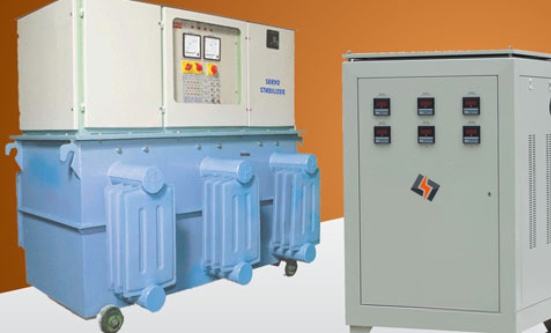STABILIZERS
Stabilizers, also known as voltage stabilizers or voltage regulators, are electrical devices designed to maintain a constant output voltage level in the presence of fluctuations or variations in the input voltage. Their primary purpose is to ensure that connected electronic equipment and machinery receive a stable and reliable voltage supply, preventing potential damage or malfunction due to voltage fluctuations.
Single-phase Stabilizer
A single-phase stabilizer, also known as a voltage stabilizer or voltage regulator, is a device designed to maintain a constant voltage level in electrical systems that experience fluctuations in input voltage. It is commonly used to protect sensitive electronic equipment and appliances from voltage variations that could potentially damage them.

In regions where the power supply is inconsistent or prone to voltage fluctuations, a single-phase stabilizer can be installed to ensure that the output voltage remains within a safe and predefined range, regardless of the input voltage fluctuations. This stabilization process is particularly important for devices like computers, refrigerators, air conditioners, televisions, and other electronics that require a stable voltage supply to operate reliably.
A single-phase stabilizer typically consists of a control circuit that continuously monitors the input voltage. When the input voltage deviates from the desired output voltage, the stabilizer uses various mechanisms (such as transformers, autotransformers, or electronic components) to adjust the output voltage to the desired level. This helps protect connected equipment from overvoltage or undervoltage conditions.
It’s important to note that there are also three-phase stabilizers available for applications that require stabilizing three-phase electrical systems.
When selecting a single-phase stabilizer, it’s essential to consider factors such as the power rating (measured in VA or kVA), the acceptable input voltage range, the output voltage regulation accuracy, and any additional features like surge protection or bypass switches. Different industries and applications may have specific requirements for voltage stability, so the choice of stabilizer should align with those needs.
Three-phase Stabilizer
A three-phase stabilizer, also known as a three-phase voltage stabilizer or three-phase voltage regulator, is a device designed to regulate and maintain a stable output voltage in electrical systems that operate on three-phase power. Just like its single-phase counterpart, a three-phase stabilizer ensures that sensitive electronic equipment and machinery receive a consistent voltage supply, protecting them from voltage fluctuations that could potentially cause damage.
Three-phase electrical systems are commonly used in industrial and commercial applications due to their efficiency and capability to handle higher power loads. A three-phase stabilizer is essential in these settings to ensure smooth operation of critical equipment, motors, and machinery that rely on a stable voltage supply.
The operation of a three-phase stabilizer is similar to that of a single-phase stabilizer, but it involves all three phases of the electrical system. Here’s a basic overview of how a three-phase stabilizer works:
Monitoring: The stabilizer constantly monitors the incoming voltage across all three phases.
Regulation: If the input voltage deviates from the desired output voltage, the stabilizer’s control circuit activates mechanisms such as transformers, autotransformers, or electronic components to adjust the output voltage of all three phases simultaneously.
Balanced Output: The stabilizer ensures that the output voltage across all three phases remains balanced and within the specified voltage range, irrespective of any fluctuations in the input voltage.
Protection: The stabilizer also often includes protection features like surge suppression, overload protection, and phase imbalance protection to safeguard connected equipment and the stabilizer itself.
When selecting a three-phase stabilizer, similar factors need to be considered as with a single-phase stabilizer: power rating (measured in kVA or MVA), acceptable input voltage range, output voltage regulation accuracy, and additional features. It’s important to match the stabilizer’s capacity to the power requirements of the connected equipment and the overall electrical system.
Three-phase stabilizers are commonly used in industries such as manufacturing, factories, data centers, hospitals, and any environment where consistent power supply is critical for the operation of machinery, automation systems, and other essential equipment.
Note:
3KVA to 500 KVA(single phase and three phase) are available

